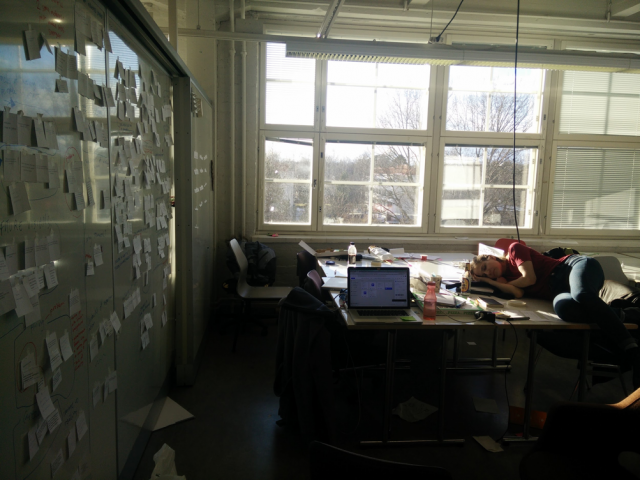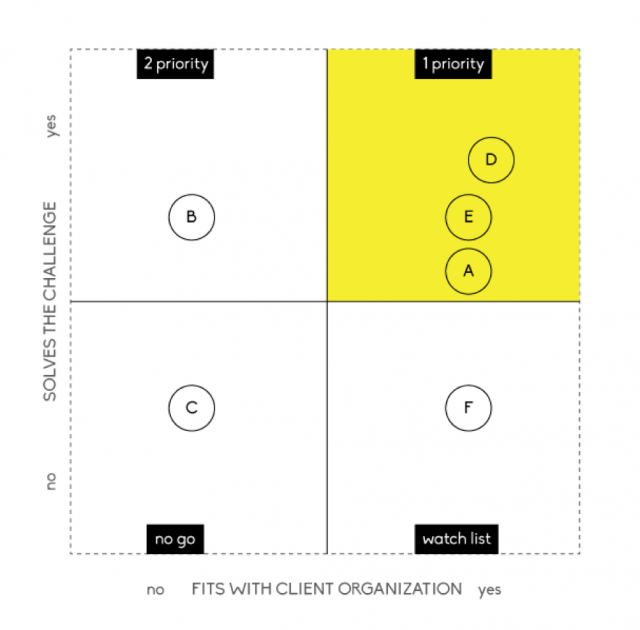The post is written by one of the two groups working with the Ministry of Finance, Ministry of Transport and Communications, Ministry of Economic Affairs and Employment, and the Prime Minister’s Office on the brief on ‘Civil Servant 2.0: Future Work of Civil Servants’. The group includes Eeva Lehto and Yiding Zhang from the Collaborative and Industrial Design program, Maya Pillai from the New Media program and Laura Domingo from the Social and Public Policy program (University of Helsinki).
Mid-review: sharing our work in progress with stakeholders
We have been working on the Civil Servant 2.0 project since February and there’s now only a few weeks until the final presentation on May 23rd. On April 4th, we had a mid-review presentation of our work-in-progress for project stakeholders from the ministries. We have had two workshops with civil servants and conducted 19 interviews partly together with the other team working on the same brief. In addition, during the whole project we have been doing desktop research on the subject. In the mid-review, we presented our findings and insights based on this research.

After the presentation, we got a lot of helpful feedback from the stakeholders and course teachers. This really helped us decide which direction we should go to next, and what are the things we still need to find out.

Choice architecture: how to affect people’s behaviour with design
After the mid-review, we dove right into the Ideation, Behavioural Insight & Proposals block. In class, Seungho Lee taught us about the different ways in which people’s behaviour can be affected with choice architecture. Choice architecture affects people’s decision-making by designing how information is presented to them. It challenges the idea of human beings as rational creatures who make deliberate choices. Instead, we are often irrational and have biases that unconsciously affect our decision making processes. Choice architecture is about recognising these biases and even taking advantage of them.
One of the key concepts of choice architecture is ‘nudging’. Nudging means steering people to make a desired decision with seemingly small means. One popular and funny example of a nudge is putting fake flies in men’s urinals to decrease spilling.
In the context of the Design for Government course, it is interesting to think how choice architecture can be used to address societal problems by incorporating it into policy making. One of the best known actors who use behavioural science and behavioural economics in policy making is the Behavioural Insights Team, that has for example managed to increase the UK’s tax revenue by 210 million pounds just by rewriting tax-reminder letters.
Critics say that nudging is basically manipulating people into making decisions that they wouldn’t otherwise make. Nudging, like any method, can of course be used for both good and evil. Some might even criticize the very idea that someone decides for you what is the “good” that you should be nudged towards. However, it’s important to remember that nothing human-made is ever completely neutral. Our designed environment is always nudging us in some direction, even if it’s not intended to do so. If behavioural aspects are not considered, we might end up nudging people to making decisions that are not good for anyone.
Time for ideas!
We started the ideation process in class with a lecture and a workshop led by Juha Kronqvist. According to him, an ideation process should have two phases: divergence and convergence. In the first phase, the aim is to be creative and come up with as many ideas as possible and not to care if they are wild and crazy. In the second phase, you bring reasoning in the mix and start thinking about which of those crazy ideas are actually do-able. So, in class, we focused on divergence with the help of different ideation exercises such as brainstorming, ‘snowballing’ and analogies and metaphors.

After the feedback we got from the mid-review and some initial ideas, we decided to revisit our data. We had learned so much since our previous analysis that it was absolutely necessary to check if we still agreed with the analysis that we had made and if there were new important and interesting findings. After making the second analysis, we were also able to evaluate some of our initial ideas for the proposal based on how well they solve the issues we have found in our research.

We evaluated our ideas on a scale of how well they solve the challenge and whether they fit in the client organization. The first is about the challenges presented in the brief and the second is about whether the proposal is do-able considering both organizational structure and culture. The better a solution fits with the client organization and the better it solves the problem, the higher priority the solution idea gets.

The final spurt
After almost 10 weeks of work, we finally have a proposal idea and are ready to move on with it with full speed. The next few weeks we will focus on developing and refining our idea. There are still a lot of big decisions to be made and a lot of work to do. We expect the final weeks of the course to be full of excitement and inspiration!
The DfG course runs for 14 weeks each spring – the 2017 course has now started and runs 21 Feb to 23 May. It’s an advanced studio course in which students work in multidisciplinary teams to address project briefs commissioned by governmental ministries in Finland. The course proceeds through the spring as a series of teaching blocks – Empathic Design, Systems Thinking and Behavioral Insight – in which various research and design methods are applied to addressing the project briefs. Blog posts are written by student groups, in which they share news, experiences and insights from within the course activities and their project development. More information here about the DfG 2017 project briefs. Hold the date for the public finale 09:00-12:00 on Tues 23 May!

